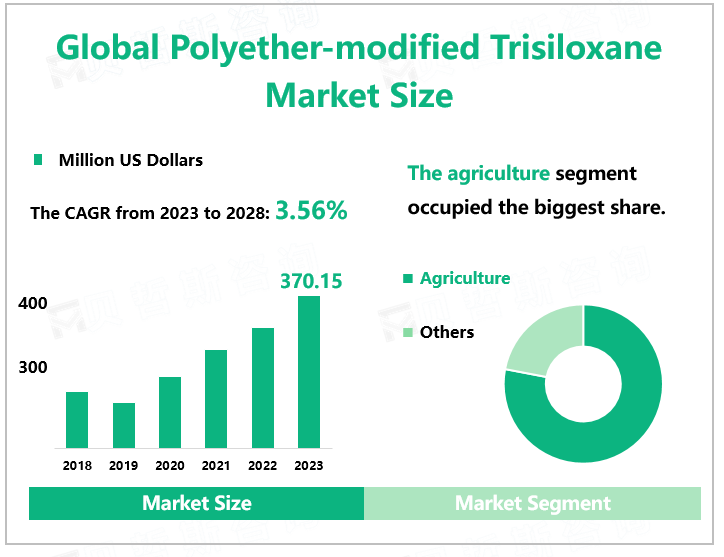Global Polyether-modified Trisiloxane Market Overview
According to Global Market Monitor, the global polyether-modified trisiloxane market size will reach $370.15 million in 2023 with a CAGR of 3.56% from 2023 to 2028.
Agriculture is the Main Application Field of Polyether-modified Trisiloxane.
Polyether-modified trisiloxane is a silicone surfactant with super-expansion ability. Polyether-modified trisiloxane molecules contain both organic groups and silicon elements, so they have the characteristics of high-temperature resistance, non-toxicity, non-corrosion, and physiological inertness of polysiloxanes while hydrocarbon surfactants have high surface activity, emulsification, decomposition, dispersion, good antistatic properties. Polyether-modified trisiloxane is widely used in agricultural auxiliaries, leather processing, textile printing and dyeing, coating auxiliaries, and other industries. With the increase in product manufacturers' output and downstream applications, the market for polyether-modified trisiloxane will further expand. The application fields of polyether-modified trisiloxane include leather field, pesticide field, textile field, and coating auxiliary field. It is related to agricultural production, FMCG products, building materials, and many other industries and types of products that are closely related to people's lives. At present, the organic silicon industry is concentrating on developing countries, especially China.

Market Drivers and Challenges
In recent years, the chemical market has become more competitive. In the process of chemical manufacturing, it is necessary to continuously improve technology and equipment to improve production efficiency and reduce pollution. The improvement can focus on improving product defects and increasing production efficiency, helping manufacturers reduce production costs and increase product profits.
Although polyether-modified trisiloxane is widely used, it has the characteristics of poor resistance to high temperatures and alkalis. The product will decompose in an alkaline and high-temperature environment, which greatly affects the use of the product. This is because the Si-O bond in the trisiloxane surfactant is relatively long, so it is easily broken by protonic acid, proton base, water, or alcohol, and difficult to add polyether-modified trisiloxane components to some formulations. Therefore, the defects in the chemical properties of the polyether-modified trisiloxane itself may affect the development of the product market, which requires manufacturers to study the product more deeply and make some improvements.
|
Drivers |
Economic development |
|
Improvement of production technology |
|
|
Growing demand from downstream fields |
|
|
Restraints |
Some defects in the product |
|
Deeper R&D is required. |
We provide more professional and intelligent market reports to complement your business decisions.